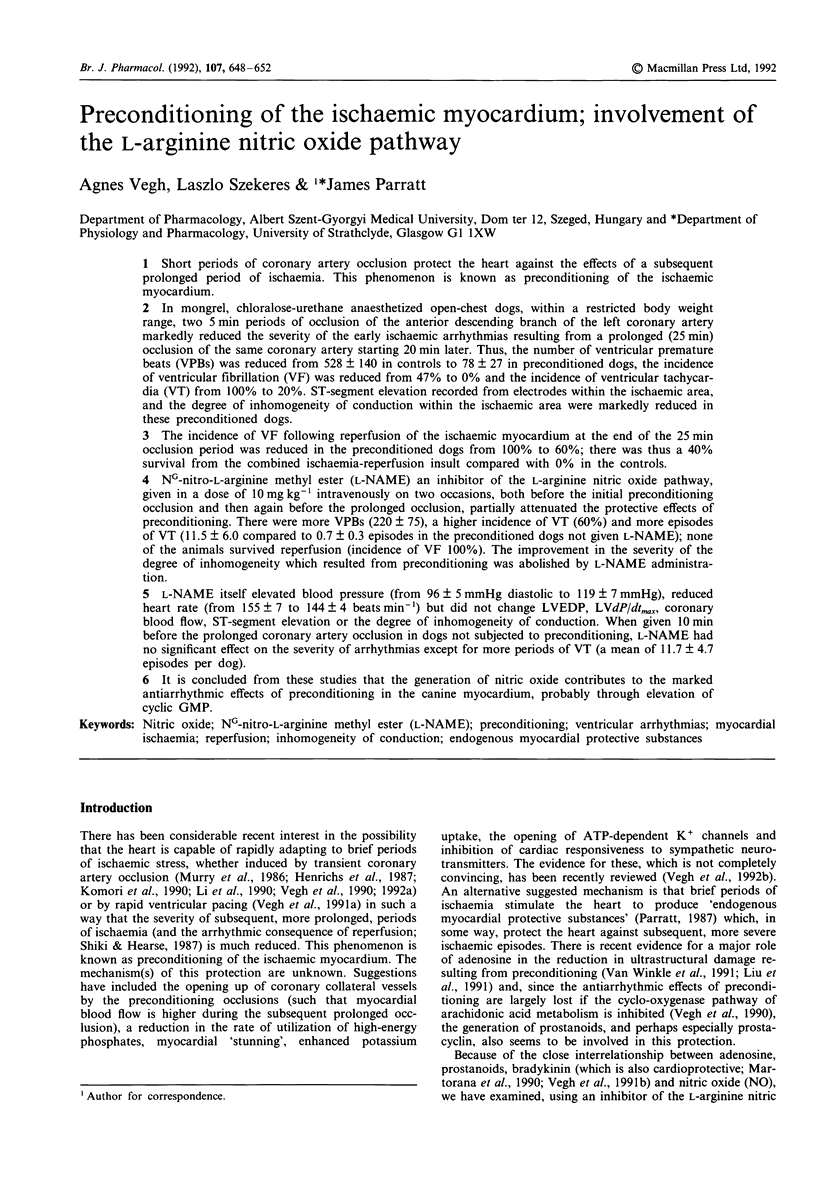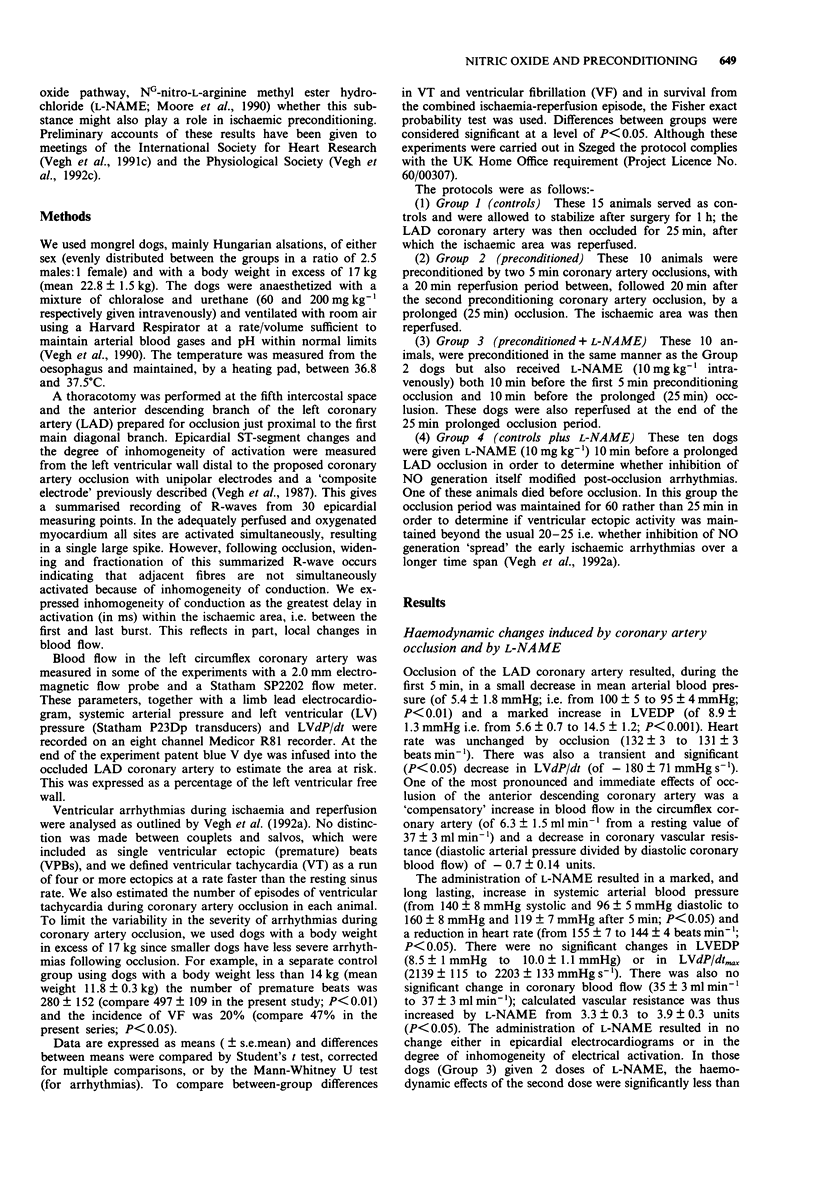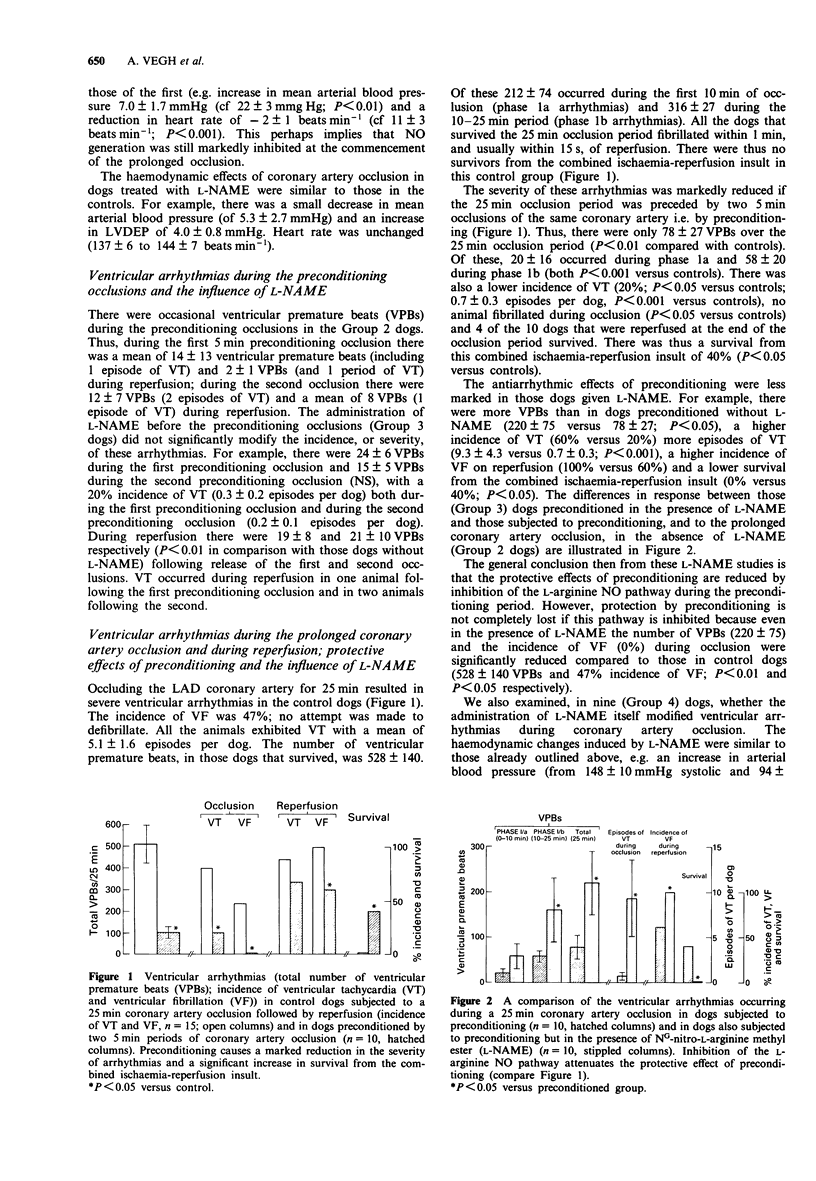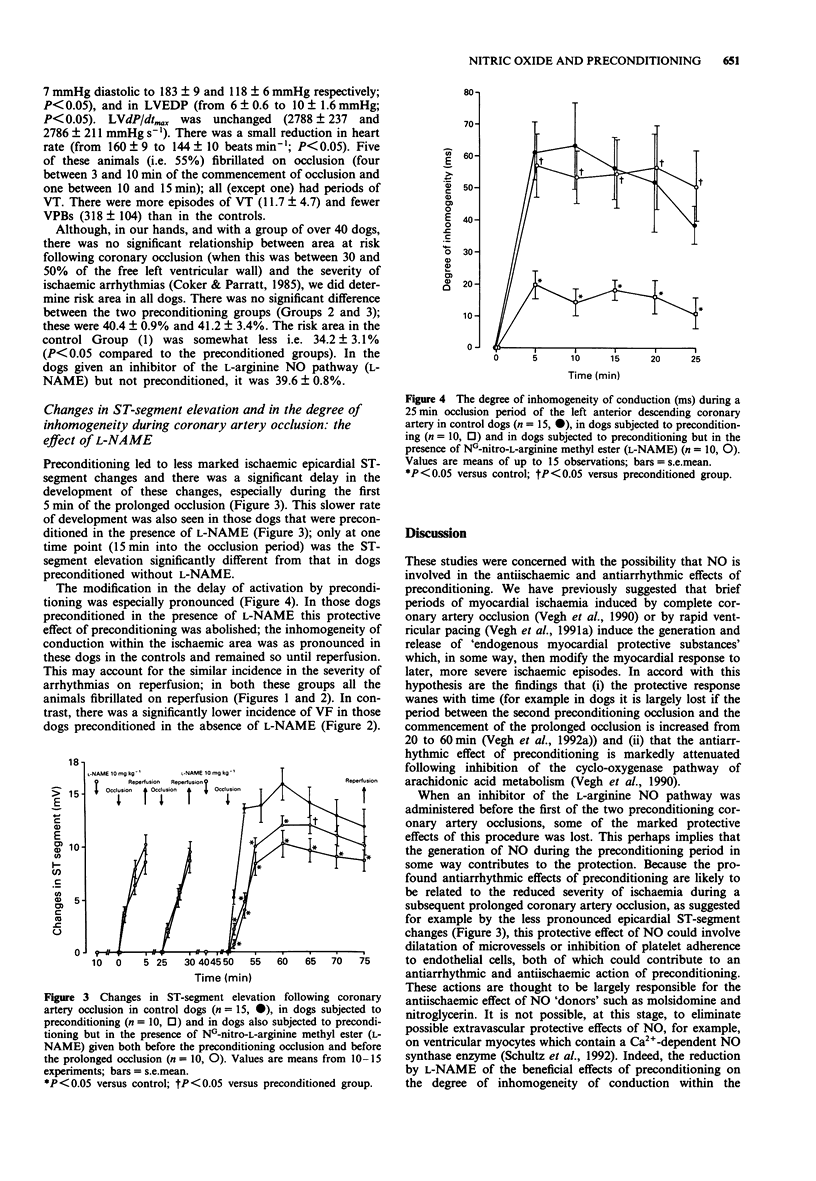Abstract
1. Short periods of coronary artery occlusion protect the heart against the effects of a subsequent prolonged period of ischaemia. This phenomenon is known as preconditioning of the ischaemic myocardium. 2. In mongrel, chloralose-urethane anaesthetized open-chest dogs, within a restricted body weight range, two 5 min periods of occlusion of the anterior descending branch of the left coronary artery markedly reduced the severity of the early ischaemic arrhythmias resulting from a prolonged (25 min) occlusion of the same coronary artery starting 20 min later. Thus, the number of ventricular premature beats (VPBs) was reduced from 528 +/- 140 in controls to 78 +/- 27 in preconditioned dogs, the incidence of ventricular fibrillation (VF) was reduced from 47% to 0% and the incidence of ventricular tachycardia (VT) from 100% to 20%. ST-segment elevation recorded from electrodes within the ischaemic area, and the degree of inhomogeneity of conduction within the ischaemic area were markedly reduced in these preconditioned dogs. 3. The incidence of VF following reperfusion of the ischaemic myocardium at the end of the 25 min occlusion period was reduced in the preconditioned dogs from 100% to 60%; there was thus a 40% survival from the combined ischaemia-reperfusion insult compared with 0% in the controls. 4. NG-nitro-L-arginine methyl ester (L-NAME) an inhibitor of the L-arginine nitric oxide pathway, given in a dose of 10 mg kg-1 intravenously on two occasions, both before the initial preconditioning occlusion and then again before the prolonged occlusion, partially attenuated the protective effects of preconditioning.(ABSTRACT TRUNCATED AT 250 WORDS)
Full text
PDF




Selected References
These references are in PubMed. This may not be the complete list of references from this article.
- Billman G. E. Effect of carbachol and cyclic GMP on susceptibility to ventricular fibrillation. FASEB J. 1990 Apr 1;4(6):1668–1673. doi: 10.1096/fasebj.4.6.2156744. [DOI] [PubMed] [Google Scholar]
- Coker S. J., Parratt J. R. Relationships between the severity of myocardial ischaemia, reperfusion-induced ventricular fibrillation, and the late administration of dazmegrel or nifedipine. J Cardiovasc Pharmacol. 1985 Mar-Apr;7(2):327–334. doi: 10.1097/00005344-198503000-00019. [DOI] [PubMed] [Google Scholar]
- Henrichs K. J., Matsuoka H., Schaper J. Influence of repetitive coronary occlusions on myocardial adenine nucleosides, high energy phosphates and ultrastructure. Basic Res Cardiol. 1987 Nov-Dec;82(6):557–565. doi: 10.1007/BF01907226. [DOI] [PubMed] [Google Scholar]
- Li G. C., Vasquez J. A., Gallagher K. P., Lucchesi B. R. Myocardial protection with preconditioning. Circulation. 1990 Aug;82(2):609–619. doi: 10.1161/01.cir.82.2.609. [DOI] [PubMed] [Google Scholar]
- Liu G. S., Thornton J., Van Winkle D. M., Stanley A. W., Olsson R. A., Downey J. M. Protection against infarction afforded by preconditioning is mediated by A1 adenosine receptors in rabbit heart. Circulation. 1991 Jul;84(1):350–356. doi: 10.1161/01.cir.84.1.350. [DOI] [PubMed] [Google Scholar]
- Martorana P. A., Kettenbach B., Breipohl G., Linz W., Schölkens B. A. Reduction of infarct size by local angiotensin-converting enzyme inhibition is abolished by a bradykinin antagonist. Eur J Pharmacol. 1990 Jul 3;182(2):395–396. doi: 10.1016/0014-2999(90)90301-l. [DOI] [PubMed] [Google Scholar]
- Moore P. K., al-Swayeh O. A., Chong N. W., Evans R. A., Gibson A. L-NG-nitro arginine (L-NOARG), a novel, L-arginine-reversible inhibitor of endothelium-dependent vasodilatation in vitro. Br J Pharmacol. 1990 Feb;99(2):408–412. doi: 10.1111/j.1476-5381.1990.tb14717.x. [DOI] [PMC free article] [PubMed] [Google Scholar]
- Murry C. E., Jennings R. B., Reimer K. A. Preconditioning with ischemia: a delay of lethal cell injury in ischemic myocardium. Circulation. 1986 Nov;74(5):1124–1136. doi: 10.1161/01.cir.74.5.1124. [DOI] [PubMed] [Google Scholar]
- Opie L. H. Role of cyclic nucleotides in heart metabolism. Cardiovasc Res. 1982 Sep;16(9):483–507. doi: 10.1093/cvr/16.9.483. [DOI] [PubMed] [Google Scholar]
- Schulz R., Nava E., Moncada S. Induction and potential biological relevance of a Ca(2+)-independent nitric oxide synthase in the myocardium. Br J Pharmacol. 1992 Mar;105(3):575–580. doi: 10.1111/j.1476-5381.1992.tb09021.x. [DOI] [PMC free article] [PubMed] [Google Scholar]
- Shiki K., Hearse D. J. Preconditioning of ischemic myocardium: reperfusion-induced arrhythmias. Am J Physiol. 1987 Dec;253(6 Pt 2):H1470–H1476. doi: 10.1152/ajpheart.1987.253.6.H1470. [DOI] [PubMed] [Google Scholar]
- Vegh A., Komori S., Szekeres L., Parratt J. R. Antiarrhythmic effects of preconditioning in anaesthetised dogs and rats. Cardiovasc Res. 1992 May;26(5):487–495. doi: 10.1093/cvr/26.5.487. [DOI] [PubMed] [Google Scholar]
- Vegh A., Szekeres L., Parratt J. R. Local intracoronary infusions of bradykinin profoundly reduce the severity of ischaemia-induced arrhythmias in anaesthetized dogs. Br J Pharmacol. 1991 Oct;104(2):294–295. doi: 10.1111/j.1476-5381.1991.tb12424.x. [DOI] [PMC free article] [PubMed] [Google Scholar]
- Vegh A., Szekeres L., Parratt J. R. Protective effects of preconditioning of the ischaemic myocardium involve cyclo-oxygenase products. Cardiovasc Res. 1990 Dec;24(12):1020–1023. doi: 10.1093/cvr/24.12.1020. [DOI] [PubMed] [Google Scholar]
- Vegh A., Szekeres L., Parratt J. R. Transient ischaemia induced by rapid cardiac pacing results in myocardial preconditioning. Cardiovasc Res. 1991 Dec;25(12):1051–1053. doi: 10.1093/cvr/25.12.1051. [DOI] [PubMed] [Google Scholar]
- Végh A., Szekeres L., Udvary E. Effect of the blood supply to the normal noninfarcted myocardium on the incidence and severity of early post-occlusion arrhythmias in dogs. Basic Res Cardiol. 1987 Mar-Apr;82(2):159–171. doi: 10.1007/BF01907063. [DOI] [PubMed] [Google Scholar]


